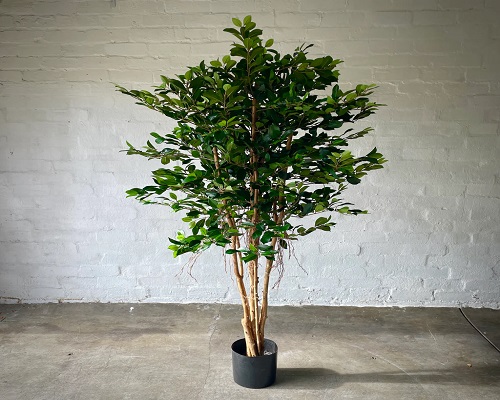
Ficus plant thrives in bright, cheerful sunshine. They like direct or indirect sunshine. Your plant will enjoy spending time outside throughout the summer, but cover it from direct sunshine. Your plant cannot handle direct or excessive sunlight, and if you do not shield it, its leaves may burn. During the winter, keep your plant away from winds and, sure, keep it out of rooms that are below 55-60 degrees F. They may be cultivated both indoors and outdoors, as a houseplant indoors and in the garden. Allow your plant to blossom as it pleases. If you don’t care ficus your place will fill with ficus bushes.
Let’s start with some of the ficus plants benefits
Air Purifying
Many houseplants can help improve the air quality in your home, but the Ficus plant Lyrata is unlike any other. By eliminating these pollutants from the air, you will feel less weary, have fewer headaches, and have more energy, and as your plant develops, it will become more efficient, further enhancing your health.
Therapeutic
Being surrounded by home plants is beneficial to your mental health, and horticulture therapy has been shown to relieve stress, alleviate dementia symptoms, and shorten the healing period for serious injuries. The act of caring for your plant might also help to alleviate sadness and anxiety.
Boosts Productivity and Cognitive Function
This also aids in memory and productivity, and the Ficus Lyrata is one of the greatest possibilities for improving this aspect of your life.
Great for Hay fever Sufferers
Fiddle Leaf Figs are an excellent houseplant for persons suffering from Hay fever because they rarely blossom when cultivated as houseplants. This allows you to appreciate the beauty of houseplants in your home without experiencing the symptoms of your allergy.
Doesn’t Need Too Much Water
The Fiddle Leaf Fig is a drought-tolerant houseplant that can live without water for an extended period of time. You may let the soil dry entirely between watering and yet have a lovely and healthy plant.
Improves sleep
The big leaves of Ficus Lyrata create a huge amount of oxygen during photosynthesis. The amount of oxygen generated by this plant is sufficient to induce a relaxed state in the brain, allowing you to settle into a deep restorative slumber. Greater sleep is associated with greater mental health and productivity.
Ficus Tree Varieties
The well-known Bodhi tree under which Buddha attained enlightenment was a Ficus religiosa, distinguished by its unique leaves with an extended drip tip. What does a ficus tree look like? The leaves are glossy, almond-shaped, and bright green, with a long pinch at the end.
Here are a few examples for types of ficus trees:
Ficus lyrata: This unusual fiddle leaf has large violin-shaped leaves that can grow to be 18 inches long.
Ficus Benjamina Starlight: This is a variegated Ficus Benjamina. It has big leaves with white splotches.
Ficus elastic: Ficus elastica is a kind of fig tree. This tree, often known as “burgundy rubber plant” or “rubber tree,” has thick glossy leaves. Ficus elastica decora has gorgeous emerald foliage, and Ficus elastica robusta has green lustrous leaves.
Ficus Benghalensis: Ficus Benghalensis is sometimes known as the Audrey ficus or the Banyan Tree. This ficus plant grows inside and is revered as India’s sacred national tree.
Where to buy ficus plants? You can buy this ficus plants near your garden nursery also many online websites available to sell this plants. Enjoy the gastronomic experiences of our Liturgical Temples food blog. Discover recipes, culinary techniques, and world cuisines.